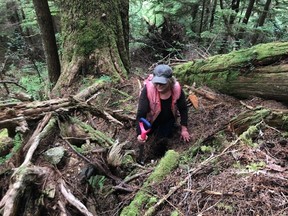Opinion: As big burns become the new normal, we need new forest management policies
Opinion: Canada’s climate strategy must account for forest sector carbon emissions and include an ecological approach to forest management

Article content
In wake of the most recent wildfire disasters, including the devastation the island of Maui and parts of B.C. continue to experience, it is high time to reflect on an ecological approach to forest management.
In the summer of 1910, a combination of drought, frequent lightning, high winds and poor forest management led to a mega-fire of three million hectares stretching across Pacific Northwest forests. Called the Big Burn, this event forever changed the way western scientists understood forests, and a new science, fire ecology, rose from the ashes.
Herbert Stoddard, one of North America’s earliest fire ecologists, focused his research on the pine savannahs of his childhood. He observed wildlife and ecosystems flourished wherever small, traditional controlled burns were maintained. As an early scientist who acknowledged First Nations’ cultural use of fire, and connected resilience from fires with ecological diversity, he argued management required a deep understanding of the unique histories of every forest.
At his research station in Georgia, Stoddard established a long-lasting experiment that today tells a 70-year-old story of a fire-adapted forest without catastrophic fires. If Canadian forest managers had only applied a similar approach adapted for each unique forest, current wildfires might be far less extensive and severe than we see today.
Future forest management policy must include honest carbon accounting.
The United Nations defines forest carbon accounting as measuring the storage of carbon in forests to guide land-use planning in order to reduce carbon emissions. In 1997, UN Secretary-General Kofi Annan said, “The world needs more (carbon) sinks and less emissions.” He put the world on alert that poor forest practices had created a climate double jeopardy in carbon budgets: forest carbon sinks were lost and vast carbon stores released with every clearcut.
Fast forwarding to the big burns of the last decade, scientists have a deeper understanding of forest dynamics and climate change. Today, they know so much more, including the potential for long-term storage of carbon in old and primary forests, which includes the generally ignored stores in forest floors and soils.
Nobel Prize winner William Moomaw has consistently argued the same accounting rigour must be applied to clearcut logging as to burning coal. In a climate context, the present matters most, and the notion that forest harvesting is carbon neutral is irrelevant because it takes hundreds of years for neutrality to occur.
Nowhere is that argument clearer than in B.C., where government data shows forest sector emissions generated in the last decade are greater than all industry sectors combined. The province has taken that information one step further, stating in two recent government reports that B.C. must change forest management practices so they support prioritizing ecosystem health and resilience over timber.
For many years those forest sector emissions were never made public. Climate experts first argued forest carbon would be transferred to harvested wood products and so stay out of the atmosphere. The reality is, however, the average lifespan of wood products is only 25 years, and accurate carbon accounting demonstrates forests do a massively better job of storing carbon than harvested wood products.
Article content
Today’s policy solutions to manage future landscapes for fire need to:
• Ban clearcutting and plantation-style forestry;
• Manage every forest type uniquely, based on cultural, ecological and disturbance histories;
• Prioritize ecosystem health over timber production, e.g., abandon the “free to grow” policy that poisons hardwoods with the herbicide glyphosate for unrealistic timber projections. For decades, glyphosate has been used in forestry and agriculture to suppress native plants in the name of enhancing crop growth. Even as it was first being applied in B.C. in the 1980s, however, studies clearly showed that dousing forest plantations with glyphosate did not improve the growth of trees. In fact, it killed deciduous trees and plants essential in slowing the spread of wildfire and maintaining forest health. In later years, multiple studies have revealed it is toxic and causes genetic changes in plants, amphibians, birds and humans and can kill certain insects and soil organisms essential for ecological balance;
• Steward old growth, primary forests, and other ecosystems that provide diversity, resilience and carbon storage;
Article content
• Account for carbon emissions from logging;
• Set targets for reducing emissions from logging.
The economic solutions arising from accurate accounting put a price on carbon in the forest sector to:
• Incentivize better forest management;
• Disincentivize carbon polluters;
• Remove subsidies with perverse outcomes like logging live trees for pellet exports;
• Provide the full cost accounting of the forest industry to the public;
• Calculate the savings if we work with, not against, nature and rural communities.
Finally, industry has to be in support of these policy changes. Throughout history, priority has been placed on finding opportunities to log the last valuable trees in existence. Arguments have ranged from salvaging logging during the beetle kill period that allowed harvesting of green wood, to recycling “waste” for pellets and claiming young trees as climate “heroes” while ignoring the larger role of mature forests in storing carbon. Today, logging in protected areas continues under the rhetoric of “reducing fire risk.”
The only solution to this new wildfire reality is changing our perspective on forest sector carbon emissions and that starts with putting ecologically driven forest management policies into practice.
Dr. Briony Penn and Dr. Rachel Holt are advisers to Mother Tree Network, an extension of the UBC Faculty of Forestry’s long-standing research study the Mother Tree Project.
No comments:
Post a Comment